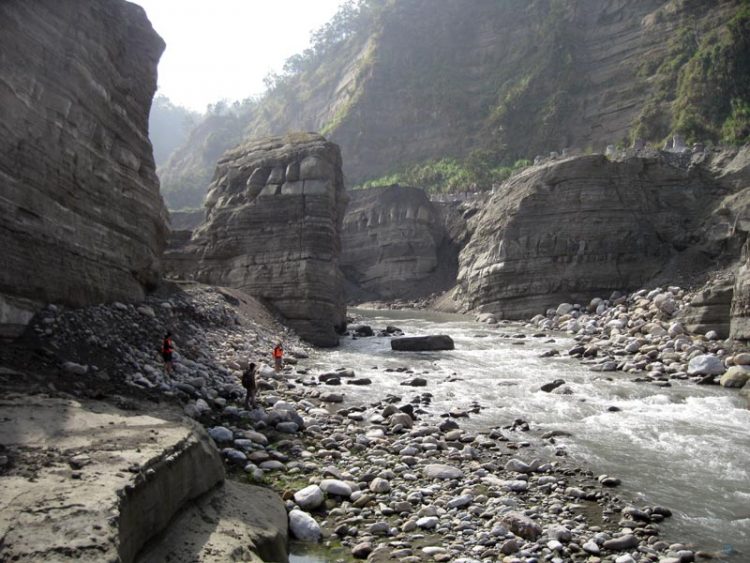Gorges are eradicated by downstream sweep erosion

Geländearbeit in der Schlucht des Da’an Chi in Taiwan. Die ein Kilometer lange und bis zu 20 Meter tiefe Schlucht hat sich in weniger als 10 Jahren nach dem Jiji-Erdbeben im Jahr 1999 gebildet. Der Felssporn in der Bildmitte wurde während eines Hochwassers 2012 im Zeitraum von einer Stunde weggespült. (Foto: Kristen Cook, GFZ)
Local surface uplift can block rivers, particularly in mountainous regions. The impounded water, however, always finds its way downstream, often cutting a narrow gorge into the rocks.
Subsequent erosion of the rocks can lead to a complete eradication of this initial incision, until not a trace is left of the original breakthrough.
In extreme cases the whole gorge disappears, leaving behind a broad valley with a flat floodplain. Previously, the assumption was that this transition from a narrow gorge to a wide valley was driven by gorge widening and the erosion of the walls of the gorges.
A team of scientists from the GFZ German Research Centre for Geosciences in Potsdam has now revealed a new mechanism that drives this process of fluvial erosion (Nature Geoscience, 17.08.2014). The geoscientists analyzed the development of a gorge on the Da'an Chi river in Taiwan over a period of almost ten years.
There, uplift that was caused by the Jiji earthquake of 1999 (magnitude 7.6), and that runs transverse to the river, had formed a blockage. Earthquakes of that size occur there every 300 to 500 years. “Before the quake there was no sign of a gorge at all in this riverbed, which is one and a half kilometers wide”, explains Kristen Cook of the GFZ.
“We have here the world's first real-time observation of the evolution of gorge width by fluvial erosion over the course of several years.” Currently the gorge is roughly a kilometer long, 25 meters wide and up to 17 meters deep. Initially, the gorge walls were eroded at a rate of five meters per year, and today are still retreating one and a half meters per year.
The scientists identified a hitherto unknown mechanism by which the gorge is destroyed. “Downstream sweep erosion” they termed this process. “A wide braided channel upstream of the gorge is necessary,” explains co-author Jens Turowski (GFZ).
“The course of this channel changes regularly and it has to flow in sharp bends to run into the gorge. In these bends, the bed-load material that is transported by the river hits the upper edge of the gorge causing rapid erosion.”
This mechanism gradually washes away all of the bedrock surrounding the gorge and, therefore, is the cause for the planation of the riverbed over the complete width of the valley. Assuming the current erosion rate of 17 meters per year, it will take here at the Da'an Chi River only 50 to 100 years until again a flat beveled channel again fills the valley.
In contrast, lateral erosion in the gorge would be too slow to eradicate the gorge in the time of one earthquake cycle. The newly discovered downstream sweep erosion is far more effective.
Kristen L. Cook, Jens M. Turowski and Niels Hovius: “River gorge eradication by downstream sweep erosion”, Nature Geoscience, Advance Online Publication, 17.08.2014, DOI: 10.1038/ngeo2224
Media Contact
More Information:
http://www.gfz-potsdam.de/startseite/All latest news from the category: Earth Sciences
Earth Sciences (also referred to as Geosciences), which deals with basic issues surrounding our planet, plays a vital role in the area of energy and raw materials supply.
Earth Sciences comprises subjects such as geology, geography, geological informatics, paleontology, mineralogy, petrography, crystallography, geophysics, geodesy, glaciology, cartography, photogrammetry, meteorology and seismology, early-warning systems, earthquake research and polar research.
Newest articles

High-energy-density aqueous battery based on halogen multi-electron transfer
Traditional non-aqueous lithium-ion batteries have a high energy density, but their safety is compromised due to the flammable organic electrolytes they utilize. Aqueous batteries use water as the solvent for…

First-ever combined heart pump and pig kidney transplant
…gives new hope to patient with terminal illness. Surgeons at NYU Langone Health performed the first-ever combined mechanical heart pump and gene-edited pig kidney transplant surgery in a 54-year-old woman…

Biophysics: Testing how well biomarkers work
LMU researchers have developed a method to determine how reliably target proteins can be labeled using super-resolution fluorescence microscopy. Modern microscopy techniques make it possible to examine the inner workings…





















